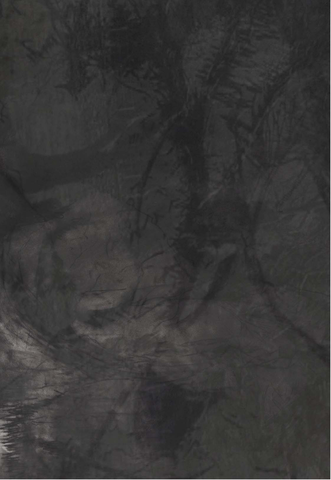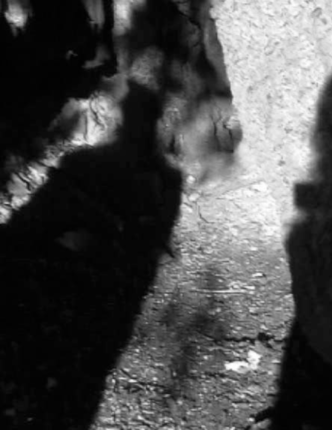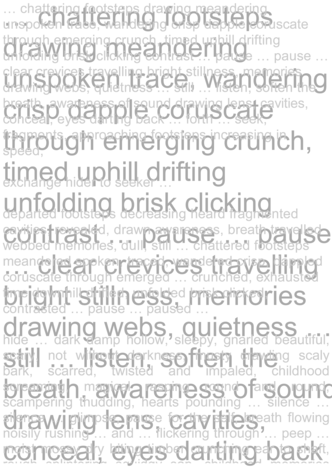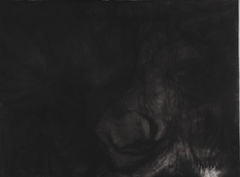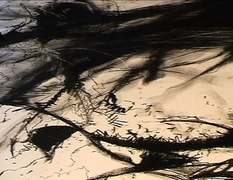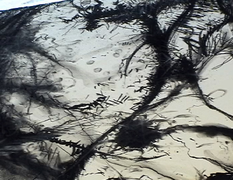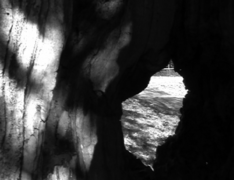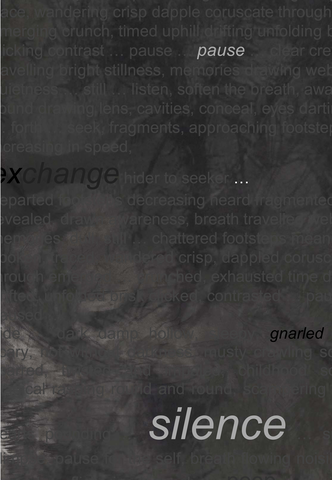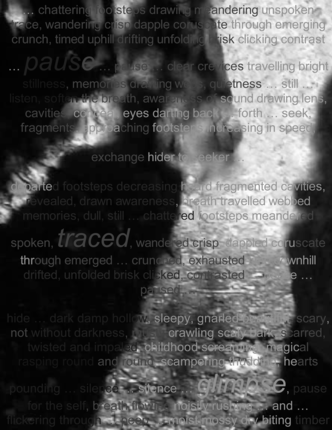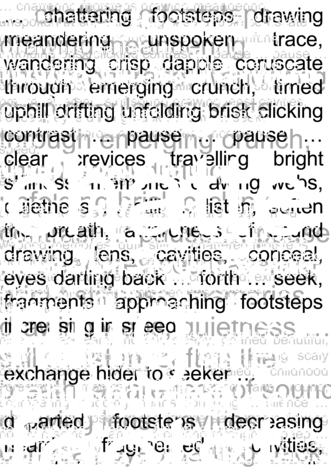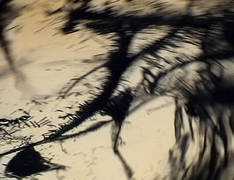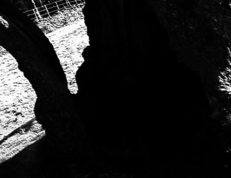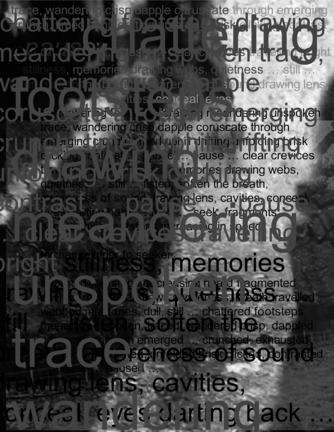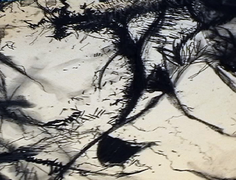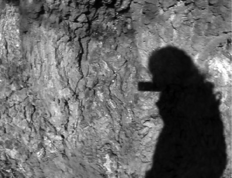The taste of tree?
Introduction
humhyphenhum are Deborah Harty and Phil Sawdon, a creative drawing research collaboration. The hums first collaborated in 2005 in response to a tripartite drawing research project between Loughborough University, Kingston University and Dublin Institute of Technology. The name humhyphenhum was adopted in 2006 to coincide with an invitation to be featured in the book Animation in Process (Selby and King, 2009). The name was adopted following observations of various features of the hums' conversations. It is an onomatopoeic use of words. i.e. hum - hum and reflects the methodology developed and employed by humhyphenhum, which is referred to as ‘meaningful play’. The methodology allows for discovery and understanding to emerge through the collaborative research process. The process of drawing commences through openness and responsiveness to discovery, and a willingness to ‘play’ with marks, media and concepts. Through a dialogue between collaborators, drawings and theme - where each has a role in co-constructing consequences - the hums’ responses, deliberations and reflections are drawn, distorted, erased and redrawn. The process is repeated time and again until an outcome of consensus is reached.
The inspiration for this research project was born out of the hums individual practices. Harty has an ongoing interest in contemporary fine art drawing as phenomenology, and its potential to uncover and communicate experience. Sawdon investigates the relationships within contemporary fine art drawing and ambiguity through text/prose, digital drawing and moving image and an emerging interest in drawing as a phenomenological process, potentially able to record the world as it appears to consciousness rather than how we perceive it to be. An awareness of Merleau-Ponty’s discussion of honey initiated humhyphenhum to research the concept of taste of tree? In The World of Perception, Merleau-Ponty (2004, p.61) suggests that, "…every quality is related to qualities associated with other senses. Honey is sugary. Yet sugariness in the realm of taste… constitutes the same sticky presence as honey in the realm of touch." Therefore Merleau-Ponty suggests that honey has a particular way of being towards us, that is:
…Honey is a particular way the world has of acting on me and my body. And this is why its various attributes do not simply stand side by side but are identical insofar as they all reveal the same way of being or behaving on the part of honey. The unity of the object does not lie behind its qualities, but is reaffirmed by each one of them: each of its qualities is the whole. Cézanne said that you should be able to paint the smell of trees... (2004, p.62).
Merleau-Ponty (2002, p.266) states, "synaesthetic perception is the rule, and we are unaware of it only because scientific knowledge shifts the centre of gravity of experience, so that we have unlearned how to see, hear, and generally speaking, feel, in order to deduce, from our bodily organization and the world as the physicist conceives it, what we are to see, hear and feel." He suggests that, when we experience, we first perceive sensory information with all of our bodies before it is split into the various senses. For example "‘hard’ produces a sort of stiffening of the back and neck, and only in a secondary way does it project itself into the visual or auditory field and assume the appearance of a sign or a word. Before becoming the indication of a concept it is first of all an event which grips my body, and this grip circumscribes the area of significance to which it has reference" (2002, p.273).
A combination of these interwoven interests initiated the concept and approach for this exposition. The research proposes drawing as phenomenology rather than a collaborative critique of phenomenology per se. The taste of tree? adopts Merleau-Ponty's philosophy and/or Cézanne's statement, as points and prompts for departure. Therefore, through dialogue and the aforementioned meaningful play, the hums inevitably pervert the original starting point by responding to discoveries during the process. The research does not attempt to illustrate or critique either Merleau-Ponty's or Cezanne's position concerning the connection of the senses. However, it does take as a point of interest the possibility that we may all experience synaethesia. The taste of tree? provides a critical commentary of the practice as research.
Within the context of the hums’ expanded definition of drawing, all outcomes within The taste of tree? are considered to be drawings, created through a process of drawing.
Context
This exposition takes a first person approach to the research, albeit through collaboration, and as such focuses on personal responses, reflections and experiences. It suggests that drawing is a phenomenological process: capable of documenting the process of drawing and the thoughts of the drawer. Whilst it is acknowledged that there are several current drawing practitioners, for example Jordan McKenzie (Drawing Breath, 2006/2012), Claude Heath (Eucalyptus, 2001), Mary-Clare Foa (Drawing the Sound in My Garden, 2009) and John Court (Marking Space, 2004), who consider aspects of drawing, phenomenology and/or the connection of the senses. This exposition locates itself within the developing field of practitioner-research, which adopts a phenomenological approach to contemporary fine art drawing. There are several practitioner-researchers undertaking research into various aspects of drawing and phenomenology, in a way that differs slightly to that discussed within this exposition. However, their research has relevance to the hums in terms of methodological approach from a first-person perspective.
Wallis (2003) creates drawn and painted self-portraits. Whilst phenomenology influences how she approaches her drawings or paintings, unlike this exposition, her research does not suggest that the making itself is phenomenological. In contrast, Bill Prosser's (2004) research does suggest that drawing is phenomenological through the presentation of text-based chapters and a series of drawings. However, the research does not specifically relate the drawings to the text or discuss the connection of the senses. Patricia Cain (2009) takes yet another angle, focusing on drawing as a means of gaining understanding, which she entitles, 'drawing as coming to know.' Cain (2009) concludes that, "...the experience of making a drawing makes visible what are essentially tacit processes in activity through our ability to make sense of what we do." Cain uses drawing as a means to understand the process of developing understanding. In contrast, this exposition uses drawing as a phenomenological process to gain understanding about the connection of the senses; drawing is used as a means to gain understanding about experience. Juliet MacDonald's (2009) first-person research concentrates on a multi-sensory approach to observational drawing as a "form of enquiry ... relating to the body and embodied experience." MacDonald used direct mark making in response to perceptions and in this sense overlaps the hums' approach. MacDonald's research also relates to Cain's in that it discusses drawing as a means of understanding perceptual processes.
Informed by the notion of Cezanne’s that it is possible to "…paint the smell of trees" (Merleau-Ponty, 2004, p.62) the hums questioned whether it would be possible to draw the taste of tree?
Approach
In discussion we questioned whether drawing a tree from observation would be sufficient to undertake phenomenological research. The hums’ position was that drawing from observation would initiate concentration on the formal qualities of the tree (shape, texture, tone etc.) rather than the effect of the experience on the senses. Experience is considered, in this context, to be a combination of external (formal qualities etc.) and internal elements (the resulting bodily/mind response). The hums considered that drawing from observation is created through presence however; drawing from memory has the potential to recall presence and any resulting responses as a part of the experience. Therefore, it was decided that drawing from collective memory, i.e. either drawing through the memory of a shared experience or the memory of a comparable experience, collated on the same surface, offered more potential for alternative perspectives and understanding of the connection of the senses. This approach is manifest in the three-fold process discussed within this commentary. The process descriptors adopted for this research are phenomenological; they are descriptive: drawing with discussion - the dialogue recorded as text forms the basis of the drawing; drawing with memory - charcoal on paper in response to recalled memories of 'treeness'; drawing with discussion and memory - drawing with moving image incorporating discussion and memory.
Process
The initial point of departure sought to both uncover whether there were common elements within the hums’ collective memories of the experience of tree and to develop a collective experience through a shared encounter. A drawing with discussion began and notes were taken in order to recall [tree] encounters and their associations. A list of words and phrases (marks) documented the discussion; rapidly identifying a common aesthetic and a common recollection of glimpses of hide and seek. These marks were redrawn as a passage of phenomenological text (drawing with discussion 1) [1] in an attempt to articulate the experience.
Having recalled experiences, the hums began drawing with memory and charcoal, documenting the recollection on paper (tree) [2]. During the process the hums became conscious that, after a period of time, a shift in emphasis occurred from drawing with memory to drawing in response to the marks as they appeared on the paper. This initiated the decision to rotate the paper in order to counteract a fixation with composition and to continue drawing with memory rather than response. The process was recorded externally with a fixed camera (stills) [3] [4] [5] [6].
A location (Bradgate Park, Leicestershire) was selected due to its notable ageing oaks - a source of memory during drawing with memory and the subsequent generation of the phenomenological text within the drawing with discussion [1]. The hums visited the location and generated a collective drawn experience with discussion and memory, through moving image.
The previous two drawings, drawing with discussion and drawing with memory [2], formed a part of the collective memories of tree influencing the approach to drawing with discussion and memory. During the process of drawing through moving image there emerged the potential to re-experience childhood memories of hide and seek through the new collective encounter. The camera drew footsteps increasing and decreasing in speed and intensity (Still 5) [7], approaching dark hollows and leaving damp recess (Still 7 & 8) [9] [10]. The hums drew with moving image the differing viewpoints passing between the seeker (Still 8) [10] and the hider drawing a period of stillness as the hider [the camera], waiting to be found, recorded the sounds of the tree with quietness from those present.
The experience of drawing with discussion and memory, through moving image, therefore, generated a collective memory of an experience of tree [hide and seek]. The hums followed the previous approach - adopted whilst drawing with discussion 1 [1] - to this collective memory by discussing the experience of drawing through moving image and consequently generating a list of words and phrases (marks). As before the hums drew a phenomenological text (drawing with discussion 2) [11] to articulate the collective experience of tree.
Having gathered all the experiences through various means of drawing: drawing with discussion, drawing with memory and drawing with discussion and memory, the next stage was to collate the research material. This commenced with the digital layering of the various generated drawings (drawing with layers) to assemble multi-sensory perceptual drawings of the experience of tree [12] [13] [14] [15] [16] [17] [18] [19] [20].
Whilst drawing with layers it became apparent that the process differed from that used whilst drawing with discussion, drawing with memory and drawing with discussion and memory. The process involved responding to developments as they emerged on screen. Previously, when drawing with memory and charcoal, it was considered detrimental to respond to the emerging developments as the hums argued it had the potential to interrupt the phenomenological process of drawing the experience of tree. However, the collation of these experiences required the hums to select the phenomenological data considered to have the most potential to record the experience of tree. It was therefore considered that a differing process to that of the previous drawings (for example, drawing with memory [2]) was required to carry this out effectively. The hums were no longer attempting to phenomenologically record the experience of tree but to create a drawing that could collate the phenomenological experiences of tree recorded in the various drawings (for example, drawing with memory and discussion [7]). The hums considered that the phenomenological data was embedded in selected drawings. Those drawings were subsequently incorporated within the drawings with layers. Therefore, it was reasonable to assume that the phenomenological data was still present, in its many forms, in the layered drawings [14] [17] [20]. The hums needed to select, collate and review the research material. Therefore, in this instance, response to, and reflection on, the emerging discoveries was considered pertinent to the task at hand.
The final stage of the research was to critically reflect on the research material in order to discover if there is the potential to draw the taste of tree. The hums considered which senses were engaged in the various experiences of tree recorded whilst drawing with discussion 1 & 2, drawing with memory and drawing with discussion and memory.
The sense of sight (hollow, glimpse, peep etc.), sound (screaming, rasping, silence etc.), touch (scaly, dry, rough etc.) and smell (musty, damp) were considered to be present in the equivalent marks (text) created whilst drawing with discussion 1 [1]. The sense of taste could be implied in the drawing with discussion through marks (text) such as dry, crunchy, biting, moist and squidgy. However, within drawing with discussion these marks related to the senses of sight, sound and touch rather than taste. To correlate them with the sense of taste would be an association of language to a given sense rather than phenomenological perceptions of taste experienced during drawing with discussion. Consequently, the sense of taste was not considered to be directly present in drawing with discussion 1.
Drawing with discussion was available as a printout and discussed whilst drawing with memory. As a consequence, it is arguable that the perceptions revealed whilst drawing with discussion served to initiate some of the recalled experiences of tree whilst drawing with memory. The hums deliberated that an equivalence of sight was present in the drawing with memory through the formal qualities of trunk, branch etc. [2] An equivalence of sound appeared in the marks that sought to emphasize the echo of footsteps [4]. An equivalence of touch appeared in the textural and gestural marks [6]. Smell didn’t appear to be directly present in the equivalence of marks; the associated smell came from the charcoal medium used to draw. As with smell, the charcoal dust created the sensation of taste, however, these were perceptions associated with the process of drawing rather than the phenomenological experience of tree. Consequently, the senses of smell and taste were not considered to be directly present in the drawing with memory.
The senses of sight, sound, touch and smell were all considered to be evident in the drawing with discussion and memory: sight through the recorded visual image [8], sound through the audio recording of the environment, touch through the close-up recording of texture [10] and smell through the recorded hums’ dialogue. The sense of taste was not thought to be directly present in the drawing either within the visual or audio recordings.
Drawing with discussion 2 [11] was created from the collective experience of tree during drawing with discussion and memory, and was considered to include (in the equivalence of mark) the senses of sight (dapple, coruscate, contrast etc.), sound (crunched, listen, quietness etc.) and touch (fragments, webs, cavities). The hums reflected that the sense of smell could be implied in the imagery conjured up by the marks (text) associated with the senses of sight, sound and touch, as these were experienced alongside the sense of smell. However, the senses of smell and taste were not considered to be directly present in drawing with discussion 2.
The above reflections revealed that the sense of smell did not always directly appear in equivalences of mark in the drawings. The sense of smell did appear in drawing with discussion 1, and in drawing in discussion and memory but not directly through an equivalence of mark in drawing with memory and drawing with discussion 2. The hums’ deliberated that whilst it was not always present as a distinct equivalent mark in each drawing, the sense of smell clearly is engaged during the experience of tree. As a consequence, the sense of smell could potentially be implied through association with the other senses, sight, sound and touch, which make up the experience of tree. Therefore, it is arguable that the experience of tree does have an associated sense of smell phenomenologically perceived. Consequently, it is capable of being recalled through the association with other senses perceived during the experience.
The collation of the research through drawing with layers [14] [17] [20] enabled the hums to bring together through the equivalent marks, created during the various drawings, the connected senses of sight (through the visual imagery), sound (drawing with discussion), touch (through visual textural and gestural marks) and smell (drawing with discussion) within one drawing. Leading to the conclusion that the senses engaged in an experience are sufficiently connected to be both transferable and recordable through equivalent marks in drawing.
However, we argue that the sense of taste did not directly appear in any of the drawing. It is therefore reasonable to assume that no sense of taste or flavour was perceived during the experience of tree and is therefore not recordable through equivalent marks in drawing the experience of tree. It is arguable that associations could be made with the other senses for example through marks (text) generated whilst drawing with discussion: dry, crunching, biting, moist and squidgy. However, these associations would be imagined rather than phenomenologically perceived during the experience of tree.
Summary
In summary, the research proposed, through the experience of tree, to engage with Merleau-Ponty’s (2004) discussion of the connection of the senses through the example of honey. Merleau-Ponty (2004) proposed that the senses, as experienced, were synaesthetic and as such, connected and therefore the taste of honey would correspond with the smell and touch of honey, each was equivocal in the other. In agreement with Merleau-Ponty, Cezanne suggested that it should be possible "…to paint the smell of trees" (Merleau-Ponty, 2004, p.62). The hums’ discovered that it was problematic to incorporate the taste of tree within the drawings at this stage, as there was no memory or association of a taste within the experience of tree. This suggests that a alternative approach may need to be adopted in order to engage with synaesthesia as this research, in its current form, has not generated an awareness of a synaesthetic experience.
The hums’ do consider that the research has addressed Cezanne’s proposal that it is possible "…to paint the smell of trees" (Merleau-Ponty, 2004, p.62). The correlation of the experienced senses allows access, through the equivalent marks in the drawings, to the senses as a whole involved in the experience. As Merleau-Ponty states when discussing the experience of honey, "…Honey is a particular way the world has of acting on me and my body. And this is why its various attributes do not simply stand side by side but are identical insofar as they all reveal the same way of being or behaving on the part of honey" (Merleau-Ponty. 2004, p.62). When discussing the experience of tree the senses engaged are sight, sound, touch, and smell. The hums argue that the correlation of these senses during the experience of tree are all present in equivocal marks in the various drawings and finally brought together in the layered digital drawings to create a phenomenological drawing of tree. Therefore, it is suggested it is possible to draw the sight, sound, touch and smell of tree, as these are all phenomenological perceptions during the experience of tree. During this research it was not possible to draw the taste of tree; however, the hums propose it may be possible to draw the taste of tree, should any researchers undertake to involve the sense of taste in the experience.
References:
Patricia Cain, ‘Drawing as coming to know: how is it that I know I made sense of what I do?’ (doctoral thesis, Glasgow School of Art, 2009)
Deborah Harty and Phil Sawdon, 'Deborah Harty & Phil Sawdon', in Animation in Process, edited by Andrew Selby (London: Laurence King, 2009), pp 154-158.
Juliet MacDonald, ‘Drawing around the body: the manual and visual practice of drawing and the embodiment of knowledge’ (doctoral thesis, Leeds Metropolitan University, 2009)
Maurice Merleau-Ponty, The Phenomenology of Perception, 1945, trans. by Colin Smith, 1962 (London, New York: Routledge, repr. 2002)
Maurice Merleau-Ponty, The World of Perception, 1948, trans. by Oliver Davis (London, New York: Routledge, repr. 2004)
Bill Prosser, 'An Archetypal Psychology of the Ordinary: an investigation through drawing' (doctoral thesis, University of the West of England, 2004)
Karen Wallis, ‘Painting and Drawing the Nude: a search for a realism of the body through phenomenology and fine art’(doctoral thesis, University of the West of England, 2003)
[1]
hide … dark damp hollow, sleepy, gnarled beautiful, scary, not without darkness, musty crawling scaly bark, scarred, twisted and impaled, childhood screaming, magical rasping round and round, scampering thudding, hearts pounding … silence … silence … glimpse, pause for the self, breath flowing noisily rushing … and … flickering through … peep … moist mossy dry biting timber crunching ear to shaft, rough splintering squidgy sap, childhood memories faraway grown from a seed, carving longevity through the stages of life, manifestation of time inspiring awe fear veil aging under the cover of darkness cast upon the ground … seek
humhyphenhum,
drawing with discussion 1, 2010
[11]
… chattering footsteps drawing meandering unspoken trace, wandering crisp dapple coruscate through emerging crunch, timed uphill drifting unfolding brisk clicking contrast … pause … pause … clear crevices travelling bright stillness, memories drawing webs, quietness … still … listen, soften the breath, awareness of sound drawing lens, cavities, conceal, eyes darting back … forth … seek, fragments, approaching footsteps increasing in speed,
exchange hider to seeker …
departed footsteps decreasing heard fragmented cavities, revealed, drawn awareness, breath travelled webbed memories, dull, still … chattered footsteps meandered spoken, traced, wandered crisp, dappled coruscate through emerged … crunched, exhausted time downhill drifted, unfolded brisk clicked, contrasted … pause … paused …
humhyphenhum,
drawing with discussion 2, 2010
